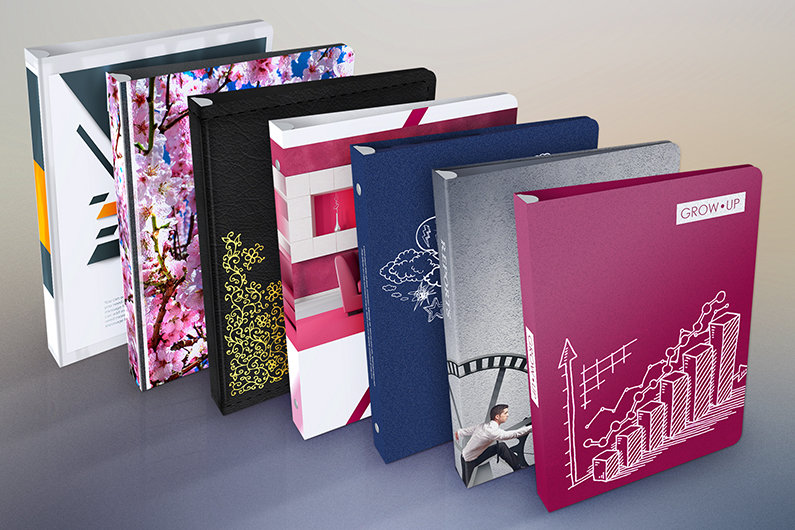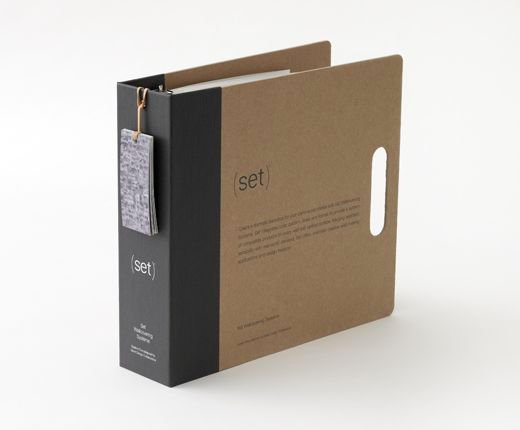Binders are a great tool for any business. They’re durable, offer plenty of storage space, and come with dozens of design choices. Yet most businesses don’t optimize these features. Their binder designs are simple—which renders them less effective.
Consumers respond best to print marketing that’s creative and innovative. They want to interact with an amazing design that captures their imaginations and builds their trust in your brand. To make a binder that meets these criteria, you’ll need to put these 4 design tips to work for your business.

Select the Proper Ring Size
As the name implies, the ring mechanism is the centerpiece of all 3-ring binders, and any printer worth their salt offers a variety of ring sizes to accommodate different marketing needs. Many businesspeople just guesstimate the ring size they want—which can spell disaster for their print marketing kit.
If the rings are too small, you’ll have loose papers sticking out of the covers; if they’re too big, the papers are more likely to get damaged because they’re not secure. Either way, using the wrong ring size makes your binder look sloppy. So what size rings do you actually need?
In short, it depends. Small rings will likely work for a client presentation, but you’ll need something larger for a sample book. You can insert your materials into sample binders to find the best fit—but it’s more effective to work with a printer that also specializes in visual design, like Company Folders. Their trained designers can help you choose the binder styles and ring sizes that will work best for your purposes.
Customize the Pockets
Most people think manufacturers predetermine the number of pockets in a binder. But in reality you can—and should—work with your printer to create custom pockets that meet your storage needs.
You can choose to add one or two pockets—or no pockets at all. Two- or no-pocket designs are pretty self-explanatory. But a single pocket helps you set the tone for your binder: placing it on the left panel gives clients all their materials up front and looks professional, while placing it on the right panel provides a little surprise at the end of the packet for a more creative feel.
You can also include custom pockets for discs, flash drives, business cards, and other media. Tailored pockets show clients that you’re organized, and they protect small items that are much more likely to fall out of or get damaged in a standard pocket.
Choose the Right Manufacturing Material
It isn’t just what’s inside that matters; your binder’s exterior is just as important. You’ll need to choose the right manufacturing material to make sure your binder protects your print materials and helps create the right sensory brand experience for your clients. Each material differs in its texture, appearance, and design options. Here’s a basic rundown:
- Poly is best for industrial or outdoor companies because this indestructible plastic is sturdy and resistant to liquid spills.
- Vinyl is an eco-friendly option that can be recycled. Since extreme temperatures can affect it, this plastic is better used indoors.
- Faux leather is a special vinyl that mimics the look and feel of leather; it’s the only option that can be padded for a plush design.
- Paper is good for including hi-res photographic designs, because it’s an easy material to print in full color.
Consider Creative Printing
Many binders simply feature a company logo, name, and contact info in the brand’s colors—which is a solid design. It portrays a clean, minimal brand identity. But if you want to take your binder to the next level, it’s time to choose more creative imprint methods.

For screen printed designs, consider adding a pattern or choosing a colorful stock for greater visual interest. Or create rich, vibrant colors and hi-res photos with four color process printing. This method works best for paper or turned edge binders, which use a special litho wrap to mimic the look of a hard cover book.
Clearview and entrapment binders let you combine colorful printed papers with plastic binders. Clear plastic pockets on the vinyl covers and spine hold paper inserts. Clearview binders are open at the top, so you can replace the inserts at any time. Entrapment binders seal the inserts permanently inside. These designs are a great chance to go green with a recyclable plastic binder and plant-based inks.
Faux leather binders also offer creative design options. Besides their capacity for plush padding, they’re the only variety capable of using textured imprint methods like foil stamping and embossing. This option is the way to go if you want to make a design that feels as cool as it looks.
Remember, your binder design will be unique to your brand. What works for your friend’s company may not work for yours and vice versa—even if you’re in the same industry. It’s important to take your time and explore options like these to create a truly effective binder.
If you like to keep all of your documents on your computer instead of a physical binder that can be arranged. At Assest Bank they store photo’s, documents and more they are one of the best digital asset management softwares out there.


